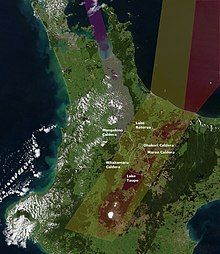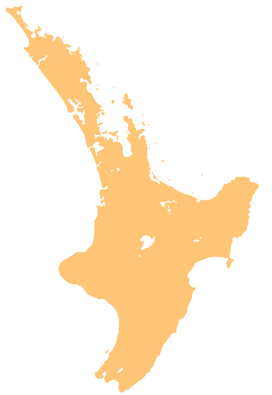Whakamaru Caldera
| Whakamaru Caldera | |
|---|---|
 The approximate immediate impact of the Whakamaru Caldera (red shading) eruptions of about 335,000 years before present. Light white shading shows where 10cm or more tephra detected noting that for example 25cm tephra is found against prevailing wind patterns well to north west of present New Zealand and 10cm south east of Banks Peninsula suggesting multiple significant events contributed. Similarly the light yellow shading does not consider all discontinuities but rather assumes that most discontinuities are due to subsequent erosion rather than landforms of this long ago, which is likely incorrect, but from immediate biosphere impact likely not significantly so. It is possible that ultimately there was worldwide biosphere impact. | |
| Highest point | |
| Elevation | 744 m (2,441 ft) |
| Coordinates | 38°25′S 175°48′E / 38.42°S 175.80°E |
| Dimensions | |
| Width | 40 kilometres (25 mi) |
| Geography | |
| Geology | |
| Rock age | |
| Mountain type | Caldera |
| Volcanic arc/belt | Taupō Volcanic Zone |
| Last eruption | Hydrothermal eruptions are contemporary, last volcanic 14,000 years ago (Puketarata) |
Whakamaru Caldera was created in a massive supereruption 335,000 years ago and is approximately 30 by 40 km (19 by 25 mi) in size and is located in the North Island of New Zealand. It now contains active geothermal areas as well as the later Maroa Caldera.
Geography
[edit]The Whakamaru Caldera covers an area larger than the younger Taupō Volcano to its south and indeed the rims overlap. To its north the more recent eruptive centres have sometimes been grouped as the Mokai Ring Complex or Maroa Volcanic Centre. It contains to its north east the more recently active Maroa Caldera with the Ben Lomond Dome being outside the southern border of the Maroa Caldera but definitely a feature of the Whakamaru Caldera.[2] Domes within the caldera include the Western Dome Complex, including Pokuru which defines its north western borders (which likely overlap with those of the older Mangakino caldera complex), Forest Road Dome, Puketarata (near Te Pouwhakatutu, which is the last Maroa Caldera eruption, now known to be 11,300 ± 1,700 years ago),[3][4] Ngangiho, which is 629 metres (2,064 ft) high but beaten by Ben Lomond 744 metres (2,441 ft), and Marotiri 733 metres (2,405 ft) just to the west of Kinloch.
Geology
[edit]The first eruptions may have occurred half a million years ago, but the period 320,000 to 340,000 years before the present have been characterised as:
- Whakamaru eruption
- Massive eruption sequence over less than a thousand years with a VEI of 8 producing 1,200 to 2,000 km3 (287.9 to 479.8 cu mi) of tephra about 335,000 years ago (330 - 340 ka).[1][5] This age in the most recent literature has slightly moved back to 340 ± 5 ka.[6] This is the largest known in the Taupō Volcanic Zone and had at least three rhyolytic and one basaltic eruption in its sequence.[7]
- Although accumulation of the magma mush may have been over more than 200,000 years there is increasing evidence that eruption only became possible over a period that may have been as short as 10 years through a rapid thermal pulse or pressure change.[7][8]
- From sea core sediment studies it is known that it deposited the widespread Mount Curl/Rangitawa Tephra, dominantly to the southeast (in addition to occurrences northwest), extending across the landmass of New Zealand, and the South Pacific Ocean and Tasman Sea. The eruption has been calculated to have been 1,500 km3 (360 cu mi) dense-rock equivalent (DRE) and modelled to have produced a Plinian column approximately 45 km (28 mi) high.[9] At the Chatham Islands which is more than 900 kilometres (560 mi) from the Whakamaru Caldera the deposits are up to 30 cm (12 in) thick. About 200 kilometres (120 mi) from the source in New Zealand itself the Rangitawa Tephra is up to 70 cm (28 in) thick[9] so a large area of the planet's biosphere would have been impacted.
- Whakamaru ignimbrite
- Found over an area of 13,000 km2 (5,000 sq mi) mainly to west of caldera
- Up to 1 km (0.62 mi) thick[2]
- Rangataiki ignimbrite
- Found mainly to east of caldera
- Mananui eruption (also termed Whakamaru 2 eruption about 330,000 to 320,000 years ago
- Mananui ignimbrite found mainly to west of caldera
- Te Whaiti ignimbrite found mainly to east of caldera and likely to be same eruptive sequence as Mananui[2]
- Paeroa eruption by 320,000 years ago on datings above[2]
- Paeroa ignimbrite is found mainly to east of caldera,[2] and is exposed by the Paeroa Fault. It has been redated to 339 ± 5 ka and assigned to a linear vent zone to the east of the caldera, which could make the Whakamaru ignimbrite older by about 20,000 years and could dissociate this eruption from the Whakamaru Caldera. The total amount of ignimbrite erupted was about 110 km3 (26 cu mi). As it may have been associated with residual magma from the Whakamaru event it can remain classified with the Whakamaru Caldera for the purposes of this article.[10]
- The Western Dome Belt eruptions
- These represent separate younger magmas that were emplaced over an extended period, from 340,000 to 240,000 years ago[2]
The Maroa Caldera eruptions can be regarded as a separate sequence of rholite eruptions commencing from 305,000 years ago continuing to as recently as 14,000 years ago:[2]
- 305,000 ± 17,000 years ago oldest Maroa dome
- 283,000 ± 11,000 years ago Korotai deposits from northern Maroa
- 275,000 to 240,000 years ago small-scale pyroclastic eruptions
- 272,000 ± 10,000 years ago Putauaki pyroclastics from a central Maroa source
- 256,000 ± 12,000 years ago Orakonui pyroclastics from a central Maroa source
- 251,000 ± 17,000 years ago onward two large parallel dome complexes developed
- 229,000 ± 12,000 years ago Atiamuri deposits from northern Maroa
- 220,000 unclear where Mokai ignimbrite that outcrop in some of Maroa area comes from
- 229,000 to 196,000 years ago Pukeahua deposits and dome building
- 11,300 ± 1,700 years ago Puketarata tuff ring formed with total volume of 0.25 km3 (0.060 cu mi)[4] in a complex series of eruptions including maar formation[3][11]


References
[edit]- ^ a b Froggatt, P. C.; Nelson, C. S.; Carter, L.; Griggs, G.; Black, K. P. (13 February 1986). "An exceptionally large late Quaternary eruption from New Zealand". Nature. 319 (6054): 578–582. Bibcode:1986Natur.319..578F. doi:10.1038/319578a0. S2CID 4332421. Retrieved 2022-05-15.
- ^ a b c d e f g Leonard, Graham S. (2003). The evolution of Maroa Volcanic Centre, Taupo Volcanic Zone, New Zealand (Thesis). University of Canterbury. Retrieved 2022-05-15.
- ^ a b Kósik, S; Hasegawa, T; Danišík, M; Németh, K; Okada, M; Friedrichs, B; Schmitt, AK (12 July 2023). "Multi-method constraints on the age and timescale of silicic small-volume eruptions of Puketerata Volcanic Complex, Taupō Volcanic Zone, New Zealand". Earth, Planets and Space. 75 (107). doi:10.1186/s40623-023-01861-0.
- ^ a b Brooker, M. R.; Houghton, B. F.; Wilson, C. J. N.; Gamble, J. A. (1993). "Pyroclastic phases of a rhyolitic dome-building eruption: Puketarata tuff ring, Taupo Volcanic Zone, New Zealand". Bulletin of Volcanology. 55 (6): 395–406. Bibcode:1993BVol...55..395B. doi:10.1007/BF00301999. S2CID 129649708.
- ^ Bryan, Scott E.; Teal R. Riley; Dougal A. Jerram; Christopher J. Stephens; Philip T. Leat (2002). "Silicic volcanism: An undervalued component of large igneous provinces and volcanic rifted margins" (PDF). Geological Society of America (Special Paper 362). Retrieved 2022-05-15.
- ^ Kidd, Maia Josephine (2021). Landscape Evolution in Ignimbrite Terrain: a study of the Mamaku Plateau, Taupō Volcanic Zone, New Zealand - Masters thesis, University of Canterbury (PDF) (Thesis).
- ^ a b Saunders, K. E.; Morgan, D. J.; Baker, J. A.; Wysoczanski, R. J. (2010). "The Magmatic Evolution of the Whakamaru Supereruption, New Zealand, Constrained by a Microanalytical Study of Plagioclase and Quartz whakamaru volcano" (PDF). Journal of Petrology. 51 (12): 2465–2488. doi:10.1093/petrology/egq064. Retrieved 2022-05-15.
- ^ Matthews, N.E.; Pyle, D.M.; Smith, V.C.; Wilson, C. J. N.; Huber, C.; van Hinsberg, V. (2011). "Quartz zoning and the pre-eruptive evolution of the ~340-ka Whakamaru magma systems, New Zealand". Contrib Mineral Petrol. 163: 87–107. doi:10.1007/s00410-011-0660-1. S2CID 56013301.
- ^ a b Matthews, Naomi; Costa, Antonio; Smith, Victoria; Pyle, David; Durant, A. (2012). "Ultra-distal Tephra Deposits from Supereruptions:Examples from Toba and New Zealand". Quaternary International. 258: 54–79. doi:10.1016/j.quaint.2011.07.010.
- ^ Downs, D.T.; Wilson, C.J.N.; Cole, J.W.; Rowland, J.V.; Calvert, A.T.; Leonard, G.S.; Keall, J.M. (2014). "Age and eruptive center of the Paeroa subgroup ignimbrites (Whakamaru group) within the Taupo Volcanic Zone of New Zealand". Bulletin. 126 (9–10): 1131–1144. doi:10.1130/B30891.1.
- ^ Kósik, S.; Németh, K.; Lexa, J.; Procter, J.N. (2019). "Understanding the evolution of a small-volume silicic fissure eruption: Puketerata Volcanic Complex, Taupo Volcanic Zone, New Zealand". Journal of Volcanology and Geothermal Research. 383: 28–46. doi:10.1016/j.jvolgeores.2017.12.008. ISSN 0377-0273. S2CID 134914216.


